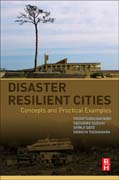
Disaster Resilient Cities: Concepts and Practical Examples
Hayashi, Yoshitsugu
Suzuki, Yasuhiro
Sato, Shinji
Tsukahara, Kenichi
Natural disasters are complex phenomena which require Structural Engineering Designers to explore different ways of thinking regarding the resilience of their structures. Structural Engineering and Natural Disaster Resilience: Concept and Practical Examples provides a blueprint for Structural Designers to better prepare structures for all types of natural hazards at the design stage. Brief and readable, Structural Engineering and Natural Disaster Resilience: Concept and Practical Examples analyses various examples of disaster damages of earthquake, tsunami, flood, together with their causal mechanisms. Practical methods to plan and design structures based on their regions, cities, as well as the particular countermeasure. Proposes new methods and policies for enhancing structural resilience for key urban infrastructureIncludes examples of disaster damage as a result of earthquakes, tsunamis, floods and their structural counter measuresCase studies cover specific mega disasters such as the Great East Japan Earthquake and tsunami, Super Typhoon Hyan, Bangkok flood INDICE: Chapter 1. Introduction - Why Resilience is Lost? Chapter 2. Emerging Crisis in Resilience over the world 2.1 The Great East Japan Earthquake (Kato T., Sato) 2.2 Mega-flood in Bangkok, Thailand (Nakamura) 2.3 Super-typhoon Haiyan in Philippines 2.4 Disaster resilience learned from the 2007 Peru Earthquake 2.5 Losing resilience of Nomadic life due to urbanization in Mongolia (Ishii) 2.6 Losing reconstruction capacity of traditional wooden houses in Japan Chapter 3. Learning Disaster Resilience from the Great East Japan Earthquake 3.1 Understanding spatial variation of tsunami 3.2 Understanding of tsunami damages as Lost Stock 3.3 Measuring damage and recovery status of residents in terms of Quality of Life Chapter 4. Regional Grand Design for Improving Disaster Resilience 4.1 Optimum sea-wall height based on risk analysis with land use and soft measures 4.2 Earthquake damage risk evaluation by micro geo data 4.3 Consensus building for resilient society 4.4 Resilient grand design based on QOL 4.5 Paradigm change in flood protection strategies for enhancing resilience (Kachi) 4.6 Smart shrink strategy and the fiscal system
- ISBN: 978-0-12-809862-2
- Editorial: Butterworth-Heinemann
- Encuadernacion: Rústica
- Páginas: 206
- Fecha Publicación: 17/03/2016
- Nº Volúmenes: 1
- Idioma: Inglés
